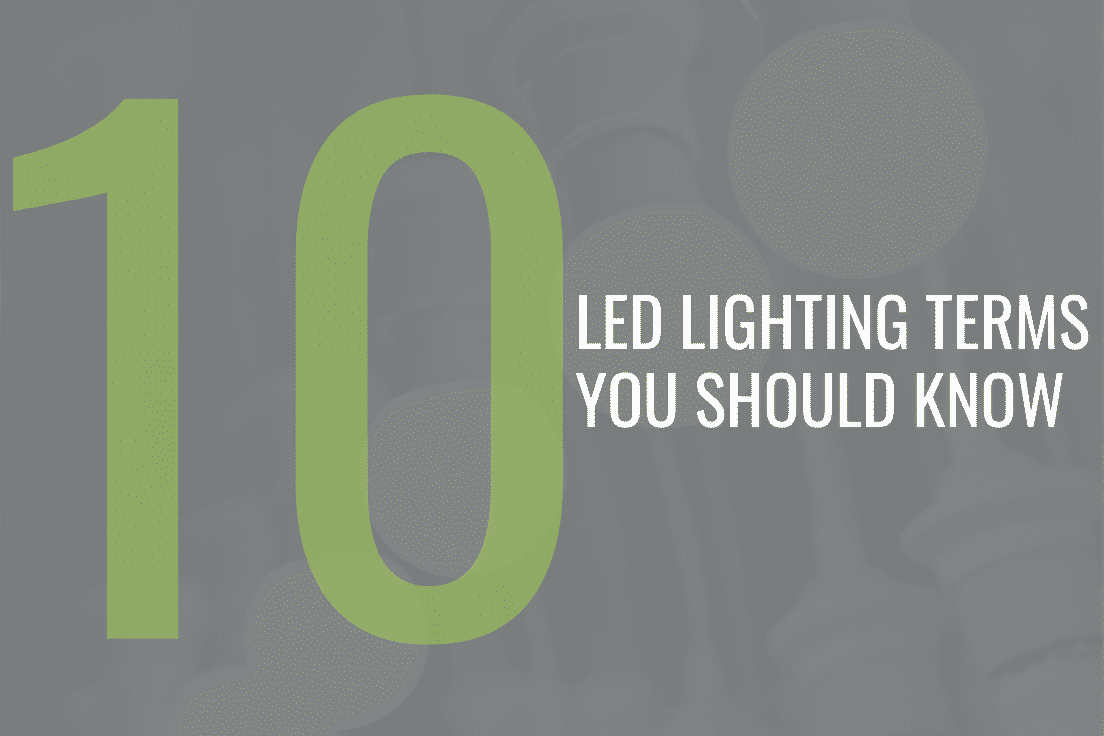Wanting to invest in a commercial LED lighting project but aren’t sure where to start? The following is a handy guide to some essential LED concepts. Knowing these LED lighting terms can help you make smart decisions and save you money, time, and headaches down the road.
1. Efficacy
“Efficacy” refers to how a fixture’s components and qualities are characterized and valued. Technically, efficacy means lumens divided by watts, so the higher the efficacy of a fixture, the better it performs. Recent fixtures generally offer 140-180 lumens per watt, and older fixtures typically offer 100 lumens per watt.
This is why you should be wary about LED lights with low lumens. The lights will likely be cheaper, but they may be older stock that is both outdated and less efficient.

A primary difference between LED lighting and traditional lighting is that the lighting output is measured in delivered lumens in LED and in lumens in traditional lighting. While it is a good idea to ask “what is the lumens” of a specific fixture, the answer will not tell the entire story.
The phrase “delivered lumens” refers to the light that is delivered to the ground. So the lumens of a traditional light may surpass that of the LED light, but the delivered lumens of the LED light may be greater than the lumens of the traditional light because the delivered lumens is measured more efficiently.
It’s a good idea to check what the delivered lumens of the LED lighting is to get a complete picture of the lighting output.
3. Footcandles
Footcandles are a factor of the amount of light delivered on the surface or the ground. Specific structures and facilities, such as factories and hospitals, are required to have a certain number of footcandles to meet regulations. For example, a manufacturing facility may require 40-50 footcandles, while a general warehouse may require 20 footcandles, and an operating room may require 150 footcandles.
When developing a lighting plan, you should be sure to check the footcandles on the ground–in addition to the lumens output from the fixtures–as well as any minimum number of footcandles required by the type of facility or structure.
4. Optics
Optics is a relatively new term with LED lighting. It technically means the way the lens surrounds the LED chip within the fixture.
With the technology evolving so quickly, now it is possible to better manipulate the lens to achieve greater control and change the optics to suit the required situation. This can change the way the light is reflected on the surface or how light spreads to the surrounding areas. A tennis court, for example, uses full cut-off optics so that light doesn’t spill into surrounding yards and instead remains concentrated on the courts.
Because the optics can be optimized to suit the specific environment for the lighting, you should be sure to explore what specific optics the LED fixture offers.
5. IP Rating
All fixtures have an IP (“Ingress Protection”) rating, which refers to the level of protection (for instance, from dust) and waterproofing the fixture offers. The higher the numbers, the greater the level of protection.
To protect your fixtures, you should look for a rating of IP 65 or higher, especially if the fixture will be used outside or in a harsher, dusty environment. Fixtures lower on the IP rating scale may be cheaper, but they will not be as durable.
6. Color Temperature
The term “color temperature” describes the color of the light that emanates from the chip within the fixture. The color temperature is measured in degrees of kelvin and falls within a spectrum, with warm, yellow light at one end (around 2700K), and cool white/blue light (around 6500K) at the other end.

You should explore the color temperature of the lighting you are considering to ensure that it matches with the lighting’s environment. For example, in many office spaces, 3000-4000K lights are preferred, but in an outdoor area, such as a stadium, at least 5000K lights would be needed.
7. Heat
You may think that LED lights do not give off any heat, but actually all lighting produces heat. The biggest detriment to an LED chip is heat, so it’s important to provide sufficient room for airflow for the LED lighting fixture. That way, the heat can be effectively dispersed.
You should also be aware that putting an LED light in a high-heat area with little airflow can void the warranty.
8. Aluminum
Lighting fixtures can be encased in different materials, with steel and aluminum being the most common. Cheaper lighting will rely on steel, which disperses heat much less efficiently than aluminum. Also, the color output will erode more quickly in the cheaper, steel-encased LED lights.
Quality lighting, on the other hand, will have aluminum housing for the fixture because aluminum is the best and most efficient material to disperse the heat that emanates from the light. You should be sure to look for LED lighting that is housed in aluminum rather than steel.
9. Driver
The driver is the most important component in an LED fixture–as well as its most common fail point. A driver is the contained power supply that regulates the power for the LED fixture.
You should ask how much the driver will cost to replace in the LED lighting and include that in the purchasing decision. Reputable drivers include Mean Well and Inventronics.
10. Rebates
Rebates are almost always available for LED lighting purchases! These rebates–along with the general energy savings that LED lights offer over time–will help to offset the initial costs of the LED purchase. You should definitely ask if there are utility rebates available in your area, since rebates are available almost everywhere.
LED lighting is evolving so quickly that it’s more important than ever to understand what features are available and what the technical terms mean before making a purchase.
The best way to get all the information discussed here about any lighting that you are considering is to examine the “spec sheet.” Most commercial LED lighting distributors and suppliers offer spec sheets for their products.
Check out LED Direct to get detailed information, spec sheets, and more resources for commercial and industrial LED lighting.

